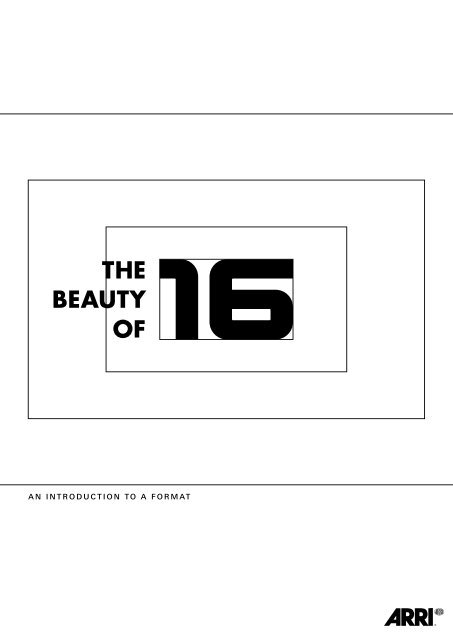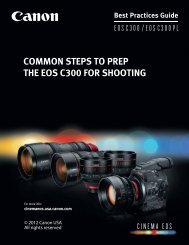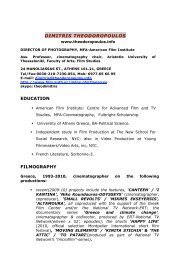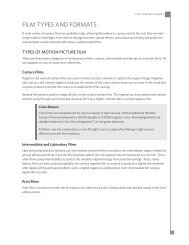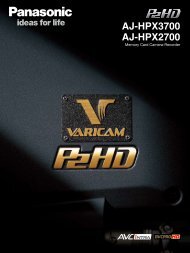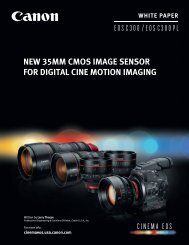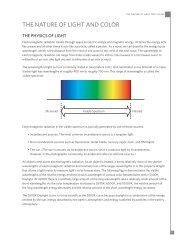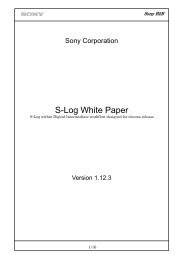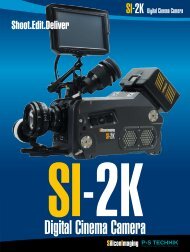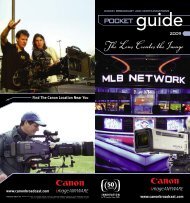An IntroductIon to A FormAt - ARRI CSC
An IntroductIon to A FormAt - ARRI CSC
An IntroductIon to A FormAt - ARRI CSC
You also want an ePaper? Increase the reach of your titles
YUMPU automatically turns print PDFs into web optimized ePapers that Google loves.
A n I n t r o d u c t i o n t o a F o r m at
T H E S U P E R 1 6 R E N A I S S A N C EIn recent years the <strong>to</strong>ols for shooting Super 16 film have maderevolutionary advances. New Super 16 cameras, lenses, films<strong>to</strong>cks, telecines, scanners and the emergence of the DigitalIntermediate process have elevated the Super 16 format <strong>to</strong>unprecedented levels of image quality and production efficiency.This new Super 16 is the ideal recording mediumfor high definition television content, independent features,commercials and documentaries alike. It combines the advantagesof film with the creative flexibility of film equipmentand economic production costs.Shooting on film has many inherent advantages, includingthe organic film look, its unsurpassed exposure latitude,natural color reproduction, long term archivability and thefact that film is the only globally accepted standard format.Creatively, Super 16 film equipment offers the greatestflexibility and superb image quality. Super 16 cameras areextremely portable and robust, while at the same time easy<strong>to</strong> operate. Their optical viewfinder allows by far the mostcomfortable, accurate and efficient way <strong>to</strong> work when capturingimages. Film cameras are fast, reliable and provide atrouble-free shooting environment on the set. They are capableof variable speeds, ramping and variable shutter angles,plus they accept a vast selection of prime, zoom and specialtylenses.R E G U L A R 1 6In its long his<strong>to</strong>ry, every conceivable subject or genre hasbeen captured on 16 mm film. Developed by Kodak in 1923as a format for hobby cinema<strong>to</strong>graphers, 16 mm soon dominatedthe market with a huge number of diverse cameras.After the Second World War, the 16 mm format became oneof the most successful professional formats ever. The 16 mmcameras were the backbone of the quickly growing televisionindustry as they became the standard <strong>to</strong>ol for capturingsport, news and documentaries. The portability and reliabilityof 16 mm assured a steady stream of content that allowedtelevision <strong>to</strong> ascend <strong>to</strong> its current popularity.S U P E R 1 6In the early 70s, 16 mm evolved further with the introductionof Super 16, invented by Rune Ericson. By utilizing thearea previously occupied by a second row of perforations oncamera negative and reserved for the soundtrack on releaseprints, Super 16 uses the maximum image area available on16 mm film. A Super 16 frame is 20 <strong>to</strong> 40% larger than aregular 16 mm frame depending on the aspect ratio chosen.The native aspect ratio of a Super 16 frame is 1.66:1, which isa good fit for the HDTV aspect ratio of 1.78:1 (19 x 9) or thetheatrical release format of 1.85:1.Regular 16 FrameSuper 16 Frame
C R E AT I V E O P T I O N S - CA M E R A S & L E N S E SPortabilitySuper 16 equipment is lighter and more compact than equipmentfor both the 35 format and HD. This makes it moremobile and faster <strong>to</strong> work with. A Super 16 camera fits in<strong>to</strong>any location, can be mounted <strong>to</strong> almost anything and can bequickly used on the shoulder or Steadicam. Productions canshoot more pages of script per day or use the extra time foradditional coverage, thus adding production value.ReliabilityFilm equipment has been developed <strong>to</strong> work under themost adverse environmental conditions, and has proven itsreliability on documentaries, features and commercials fromthe Amazon jungle <strong>to</strong> the <strong>An</strong>tarctic and from the deepestunderwater shoots <strong>to</strong> outer space. It is built <strong>to</strong> the highestmechanical and optical standards by craftsmen who assembleeach camera and lens individually, and the equipment mustadhere <strong>to</strong> temperature specifications beyond those of professionalvideo cameras.Optical ViewfinderOpera<strong>to</strong>rs see a full-color image in the optical viewfinderof a film camera, and are able <strong>to</strong> accurately judge focus fora first, on-set quality control. Optical viewfinders show anarea larger than the image recorded on film, ensuring thatmicrophones, light stands and other debris do not make anappearance, thus minimizing the need for re-takes and savingprecious time on the set. Opera<strong>to</strong>rs find this extra areaaround the image also crucial for precise composition andexacting camera movements. In addition, optical viewfinderswork without power, are less fatiguing <strong>to</strong> the eye thanelectronic viewfinders and can be equipped with a range ofaccessories like medium and long eyepiece extensions, eyepiecelevelers and heated eyecups.Easy To OperateSimple controls that are designed <strong>to</strong> assure safe operationand that work even in severe weather are the hallmark of filmcameras. With the film look preset in the film s<strong>to</strong>ck chosen,all the assistant has <strong>to</strong> worry about is the frames per secondrate and the shutter angle, which can easily be changed whenrequired. That's it.Optical viewfinder imageH D T V 1 . 7 8Camera Creative OptionsFilm cameras offer plenty of creative options lacking in otherformats. They can be easily run at variable speeds <strong>to</strong> createslow motion or time-lapse effects. The same technique, if appliedmore subtly, can stretch or compress time for a bit morekick, more pleasing, fluid motion or increased suspense in ascene. Ramps even allow a change of speed within a scene.Different shutter angles can add motion blur or a hyper-reallook. All these options are built in<strong>to</strong> the cameras and can beused without any extra cost in post production.
C R E AT I V E O P T I O N S - CA M E R A S & L E N S E SLenses Creative OptionsModern Super 16 cameras can be equipped with lenses built for the Super 16format, but they also accommodate the vast array of 35 format lenses. Thisoffers unique perspectives that are not available in video formats. Theselenses include the highest quality of standard prime and zoom lenses, highspeed lenses, macro lenses, diopters, lightweight zooms, super long zooms,zooms with a super wide range, extreme wide angle lenses, fisheye lenses,extreme telepho<strong>to</strong>s, shift & tilt lenses, tilt focus lenses, reverse perspectivelenses, and numerous others including the ever popular squishy lens.Getting closer: a shot taken with a 16 mm camera, a highspeed100 mm lens and a set of diopters.Starting wide: an establishing shot taken with a rectilinear 8 mm extreme wide angle lens.Right up close: a macro shot taken with a 16 mm cameraand a 100 mm macro lens.Going fast: the same 8 mm lens can put the viewer right in the middle of the action.
P R O D U C T I O NEven though Super 16 is used for all kinds of projects, itsmost common use <strong>to</strong>day is for television productions andindependent features. The three most common types of productionsare detailed below.1. Shoot Super 16, Post Video, Broadcast HDBroadcasters <strong>to</strong>day are demanding content <strong>to</strong> be deliveredin HD, and shooting Super 16 is the best way <strong>to</strong> create highquality HD programming.The production is shot on Super 16 film, and then transferred<strong>to</strong> standard definition (SD) or high definition (HD)video on a telecine. Modern telecines can extract most of theimage information from Super 16 film, and are one reasonfor the continued popularity of this format. Post productioncommences on SD or HD equipment in the traditionalfashion, as does broadcast on SD or HD. This workflowmaintains all the advantages of film and the creative optionsof film cameras and lenses. Once the program is aired, thefilm-originated material can be re-transferred <strong>to</strong> any foreignor future television standard.2. Shoot Super 16, Post DI (Data), Theatrical ReleaseThe Achilles heel of shooting Super 16 for a theatrical releasehas always been the optical blow-up required <strong>to</strong> get from theSuper 16 camera negative <strong>to</strong> a 35 mm release print. This opticalblow-up is now being replaced by the Digital Intermediate(DI) process, which is quickly becoming a mainstreamproduction <strong>to</strong>ol.The production is shot on Super 16 film, and then scannedon a pin-registered film scanner. Modern film scanners canrecord all the image information present on Super 16 film.The resulting image data is used for editing, special effectsand color correction. Once in the digital realm, there is almostno limit <strong>to</strong> the image manipulations, effects or looksthat can be created. The finished image data is then recordedon<strong>to</strong> 35 mm film with a modern film recorder <strong>to</strong> create 35mm release prints. Since the DI process is completely transparent,there is no image quality loss incurred by going froma Super 16 camera negative <strong>to</strong> a 35 mm release print.Richard Crudo, ASC, President of the American Societyof Cinema<strong>to</strong>graphers, said in the article Go with the Flowfrom Film & Video Magazine: “ going <strong>to</strong> c in 16 DI bcom m mbl d cp.Ppl going <strong>to</strong> y, 'My God, look qlity you c out of this.'”3. Shoot Super 16, Post DI (HD Video), Theatrical ReleaseA hybrid option combining the other two workflows is alsopossible when a theatrical release is required from a Super 16negative at rock bot<strong>to</strong>m costs. The film is transferred by atelecine <strong>to</strong> HD video instead of scanned <strong>to</strong> image data. Postproduction is done in HD video, and the feature is output<strong>to</strong> 35 mm film on a film scanner. The result has slightly lessimage quality than a true data DI post production, but issubstantially faster and less expensive.1. Shoot Super 16, Post Video, Broadcast HDShoot Super 16telecineSD/HDpost productionSD/HDbroadcast2. Shoot Super 16, Post DI (Data), Theatrical ReleaseShoot Super 16 scanner DI post production 35 mm release print3. Shoot Super 16, Post DI (HD Video), Theatrical ReleaseShoot Super 16 telecine HD post production 35 mm release print
F R O M T H E F I E L DThis is but a small selection of some of the most successfulproductions captured on Super 16 film from all over theworld.Germany - MercedesUSA - Sex and the CityCinema<strong>to</strong>grapher Thomas S<strong>to</strong>kowski measuring the light level for the MercedesMonopos<strong>to</strong> classic car. Copyright Mercedes-Benz & GutsyPicture by Craig Blankenhorn, Courtesy of HBO.Initially an acclaimed hit in the United States, Sex and theCity now airs internationally in over a dozen countries fromEurope <strong>to</strong> Asia. The show follows four fashionable womenas they navigate relationships and define what being single<strong>to</strong>day means. Known for its glamorous look, Sex and theCity shot Super 16, often on location <strong>to</strong> showcase New YorkCity’s street life, hip bars, restaurants and clubs.“W likd <strong>to</strong> kp cm moving w it w pprop, d strivd for strong compositions d bful lighting.Sup 16 d dvcd <strong>to</strong> point w w d widy of l d cc our displ, d lw d low profil md for f pc,” says Direc<strong>to</strong>rMichael Spiller. Spiller began on the series as direc<strong>to</strong>r of pho<strong>to</strong>graphythe first four seasons before going on <strong>to</strong> direct. “Wof w shooting in b or d d <strong>to</strong> in d out of w d two loc dy.W you v six p <strong>to</strong> shoot d wlls don't mov,ving nic trim cm pck cly lpd ccomplish. W w fd <strong>to</strong> vid, w found l 16mm high-spd s<strong>to</strong>cks lly ld up, d w d rich im most ppl just md w shot on 35 mm.”DaimlerChrysler is currently building nine large brandcenters worldwide, containing a car dealership, museums,retail s<strong>to</strong>res and event spaces. DaimlerChrysler UK wantedan image film for the UK center, <strong>to</strong> be known as Mercedes-Benz World at Brooklands. They brought 27 unique classicMercedes cars in<strong>to</strong> a studio near Stuttgart in Germany, andrecorded au<strong>to</strong>mobile his<strong>to</strong>ry on Super 16 film.Because of scheduling difficulties, one car had <strong>to</strong> be sho<strong>to</strong>n its own up front. Even though the project was scheduled<strong>to</strong> be shot on video, cinema<strong>to</strong>grapher Thomas S<strong>to</strong>kowskiand Direc<strong>to</strong>r Paul O'Brien convinced DaimlerChrysler <strong>to</strong>shoot this car on Super 16. Paul O'Brien: “y y lvd lovd sult. Thom d v film chniq lik vbl spd,spd mps d smll l, d , in combtion with rich film look, convincd m <strong>to</strong> shoot ll cin Sup 16. f d x d dpth you only with film, it w bful d worth vy c.Plus y lik fct y c purp this f; v will go in<strong>to</strong> Mcd chiv d y cf it <strong>to</strong> wv vid or dl im dd willb dd in f. This is his<strong>to</strong>ricl ml d w ldy in discussions with Mcd on for thisf.”
F R O M T H E F I E L DFrance - March of The PenguinsUK - The Virgin QueenCinema<strong>to</strong>grapher Laurent Chalet and one of his protagonists.Picture courtesy of Laurent ChaletCinema<strong>to</strong>grapher David Odd, BSC, on the set of The Virgin Queen.Pho<strong>to</strong>graph by Nick BriggsMarch of the Penguins (La Marche de l'empereur), directedby Luc Jacquet, won Best Foreign Film at the 2006 AcademyAwards. The documentary uses captivating images <strong>to</strong> tracethe truly remarkable annual journey of Emperor penguins,as they travel across the unforgiving desolation of the <strong>An</strong>tarctic<strong>to</strong> their traditional breeding grounds. They traverse aregion so bleak, so extreme, it supports no other wildlife atthis time of year. Their loving care for their young stands instark contrast <strong>to</strong> the foreboding cold of their environment.The Virgin Queen is a four part BBC mini-series exploringthe life of Queen Elizabeth I. The show, which also aired onPBS’s Masterpiece Theater in the USA. It is a riveting retellingof the reign of the most famous daughter of Henry VIII.Elizabeth is portrayed as a person <strong>to</strong>rn between a real senseof duty <strong>to</strong> her nation and desire of all kinds. As she fights heradvisors and Parliament for the right <strong>to</strong> rule without a man ather side, she longs for the one man she has always loved, andcan never have, the married commoner Robert Dudley.March of the Penguins is one the most successful theatricaldocumentaries ever made. Its <strong>to</strong>tal gross, which s<strong>to</strong>odat $77,000,000 in November of 2005, makes it the secondhighest earner among documentaries of all time, behind onlyFahrenheit 9/11. Cinema<strong>to</strong>grapher Laurent Chalet explainswhy he chose <strong>to</strong> shoot on Super 16 film: “, First, w w wd wd <strong>to</strong>shoot on film, not on y lctronic mdium. film im spcl qlity, it is vy xpv, somw m l.35 mm quipm would v b <strong>to</strong>o vy - w w two-ppl cw most of tim, Jm M d mylf,d Sup 16 v us mobility. Scond, film is b in cold. W d no problm ll with cm or film during y of shooting in Actic, v -30ºC.”The show's cinema<strong>to</strong>grapher, David Odd, BSC, said:“W W shot l lot in cdll cdllight d d by fil filight <strong>to</strong> w show l lity of tim. W w ching cpbil of vything, d I got fc c out of 250 d500 ASA s<strong>to</strong>cks w d. For c, I would dmcllyovxp windows, d d m mvly downin post <strong>to</strong> bring bck dfinition. This could not v bd without film.” Mr. Odd is one of the busiest cinema<strong>to</strong>graphersin the UK, shooting mostly Super 16. “ wy wfilm <strong>to</strong>dy is bout how much you c do in dy, how muchyou c cv. Som of most succful ppl will llyou c <strong>to</strong> cving is <strong>to</strong> kp it simpl. <strong>An</strong>d Sup16 simplicity is not in HD. With Sup 16,you v l, cm d roll of film. <strong>An</strong>d with filmyou v fdom, lbility, cvity d lvity.”
F R O M T H E F I E L DCanada - Godiva'sIndia - Taxi 9211Head chef Ramair (middle) serves up an illuminating mealCinema<strong>to</strong>grapher Kartik Vijay checks the lighting inside a luxuriously equipped TaxiGodiva's is a comedic drama about a fast-paced restaurantin Yale<strong>to</strong>wn, Vancouver Canada. Godiva's is a funky canteenthat is home <strong>to</strong> ten exiles. It shows their high energyentanglements behind the backdrop of the high pressure,fast-paced world of the restaurant business. In their structure,depth and audacity, the s<strong>to</strong>ries presented in this showaim <strong>to</strong> rise above the usual television fare.Cinema<strong>to</strong>grapher Bruce Worrall, <strong>CSC</strong> notes, “ To m, m,16mm off qlity d flxibility d from , fdom<strong>to</strong> xc cvity. is bl qlity ofpphy, physicl dim d unpcddld. xp offd by <strong>to</strong>dy's film s<strong>to</strong>cksbl 16 mm form, w dld cctly, <strong>to</strong> rivly cpturing mdium on mk <strong>to</strong>dy.”Taxi 9211 is an independent feature film shot in Bombayon Super 16 film. It’s about a day when two strangers withbig egos meet and the wreckage that follows thereafter. Cinema<strong>to</strong>grapherKartik Vijay feels that the huge success of thisfeature is based on the fact that "it combines the traditionalIndian movie formula of love and relationships with a 'newage' sensibility." He also credits the ac<strong>to</strong>rs, as well as direc<strong>to</strong>rMilan Luthria and producer Ramesh Sipp.“ dc dcision <strong>to</strong> shoot Sp Sup 16 w w mly mly dv driv bybud,” explains Kartik Vijay, “b “b but l l lso bc bc bc I kw kw kw shoot involvd lot of dld work, in tight cd insid cbs d c. Sup 16, with its smll cm, spcl l d w Vision2 s<strong>to</strong>cks, d w Idd <strong>to</strong> giv this film look it dvd.”
F R O M T H E F I E L DAustralia - McLeod’s DaughtersThe award-winning television series McLeod’s Daughters isnow in its sixth season and going strong. It is the s<strong>to</strong>ry ofClaire and her sister Tess, who are reunited on the Drover'sRun family farm in the Australian Outback after a long separation.After firing the male workforce, they decide <strong>to</strong> runthe property themselves with the help of housekeeper MegFountain, her daughter Jodi, and local girl Becky. The showdepicts the growing bond between the sisters, including Tess'decision <strong>to</strong> stay at Drover's permanently, as well as their relationshipswith the neighboring Ryan brothers and otherswithin the district.Russia - Stag HuntingMcLeod's Daughters is being shot on a ranch just outsideof Gawler in South Australia, which acts as a wide openbacklot. Cinema<strong>to</strong>grapher Roger Dowling, ACS notes,“ dcision <strong>to</strong> shoot on Sup 16 w bclly md by produc <strong>to</strong> mk it <strong>to</strong> ob ov l y dd 'mc look of film ov vid. 70% of shooting for McLd's D k plc outdoors. W shooting full pisod in 5-7 dys, kping two full cwsshooting cly. pbility of Sup 16 cmmk it quick d .”Cinema<strong>to</strong>grapher Michael Mukasey on the set of Stag HuntingIn 2005 Michael Mukasey, cinema<strong>to</strong>grapher and owner ofthe camera rental house Rentacam in Moscow, shot the popularRussian TV series Stag Hunting (Okhota na izubrya)on Super 16 for Channel 1 (ORT).Mr. Mukasey said “W shot Sup 16 bc w did notw vid/dl look. Sup 16 looks lik film, but is lxpv 35 mm. Shooting Sup 16 is just lik shooting35, xcpt quipm is smll. Ow it is just m in ms of lighting, colors, composition d DI.”This “The Beauty of 16” introduction (K5.40057.0) is published by:Arnold & Richter Cine Technik, April 07, 200610


